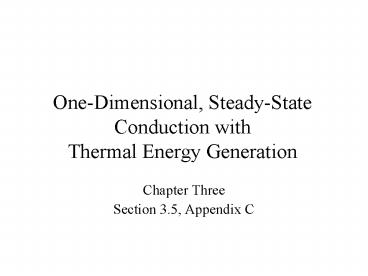OneDimensional, SteadyState Conduction with Thermal Energy Generation - PowerPoint PPT Presentation
1 / 12
Title:
OneDimensional, SteadyState Conduction with Thermal Energy Generation
Description:
Problem: Nuclear Fuel Rod (cont. ... to the schematic, where might radiation effects be significant? Problem: Nuclear Fuel Rod (cont. ... – PowerPoint PPT presentation
Number of Views:155
Avg rating:3.0/5.0
Title: OneDimensional, SteadyState Conduction with Thermal Energy Generation
1
One-Dimensional, Steady-State Conduction with
Thermal Energy Generation
- Chapter Three
- Section 3.5, Appendix C
2
Implications
Implications of Energy Generation
- Involves a local (volumetric) source of thermal
energy due to conversion - from another form of energy in a conducting
medium.
- The source may be uniformly distributed, as in
the conversion from - electrical to thermal energy (Ohmic heating)
or it may be non-uniformly distributed, as in the
absorption of radiation passing through a
semi-transparent medium.
For a plane wall,
- Generation affects the temperature distribution
in the medium and causes - the heat rate to vary with location, thereby
precluding inclusion of - the medium in a thermal circuit.
3
The Plane Wall
The Plane Wall
- Consider one-dimensional, steady-state
conduction - in a plane wall of constant k, uniform
generation, - and asymmetric surface conditions
- Heat Equation
- General Solution
What is the form of the temperature distribution
for
4
Plane Wall (Cont.)
Symmetric Surface Conditions or One Surface
Insulated
- What is the temperature gradient
- at the centerline or the insulated
- surface?
- Why does the magnitude of the temperature
- gradient increase with increasing x?
- Temperature Distribution
- How do we determine Ts ?
Overall energy balance on the wall ?
- How do we determine the heat rate at x L?
5
Radial Systems
Radial Systems
6
Radial Systems (Cont.)
- Solution for Uniform Generation in a Solid
Sphere of Constant k - with Convection Cooling
Temperature Distribution
Surface Temperature
Overall energy balance
Or from a surface energy balance
- A summary of temperature distributions is
provided in Appendix C - for plane, cylindrical and spherical walls, as
well as for solid - cylinders and spheres. Note how boundary
conditions are specified - and how they are used to obtain surface
temperatures.
7
Problem Nuclear Fuel Rod
Assumptions (1) Steady-state conditions, (2)
One-dimensional conduction, (3) Constant
properties, (4) Negligible contact resistance,
(5) Negligible radiation, (6) Adiabatic surface
at r1.
8
Problem Nuclear Fuel Rod (cont.)
Analysis (a) The outer surface temperature of
the fuel, T2 , may be determined from the rate
equation
where
The heat rate may be determined by applying an
energy balance to a control surface about the
fuel element,
Since the interior surface of the element is
essentially adiabatic, it follows that
Hence,
With zero heat flux at the inner surface of the
fuel element, Eq. C.14 yields
9
Problem Nuclear Fuel Rod (cont.)
Since T1 and T2 are well below the melting points
of thorium and graphite, the prescribed operating
condition is acceptable.
(b) The solution for the temperature distribution
in a cylindrical wall with generation is
Boundary conditions at r1 and r2 are used to
determine T1 and T2.
10
Problem Nuclear Fuel Rod (cont.)
The following results are obtained for
temperature distributions in the graphite.
11
Problem Nuclear Fuel Rod (cont.)
Using the value of T2 from the foregoing
solution and computing T3 from the surface
condition,
the temperature distribution in the graphite is
12
Problem Nuclear Fuel Rod (cont.)
(ii) Referring to the
schematic, where might radiation effects be
significant?

